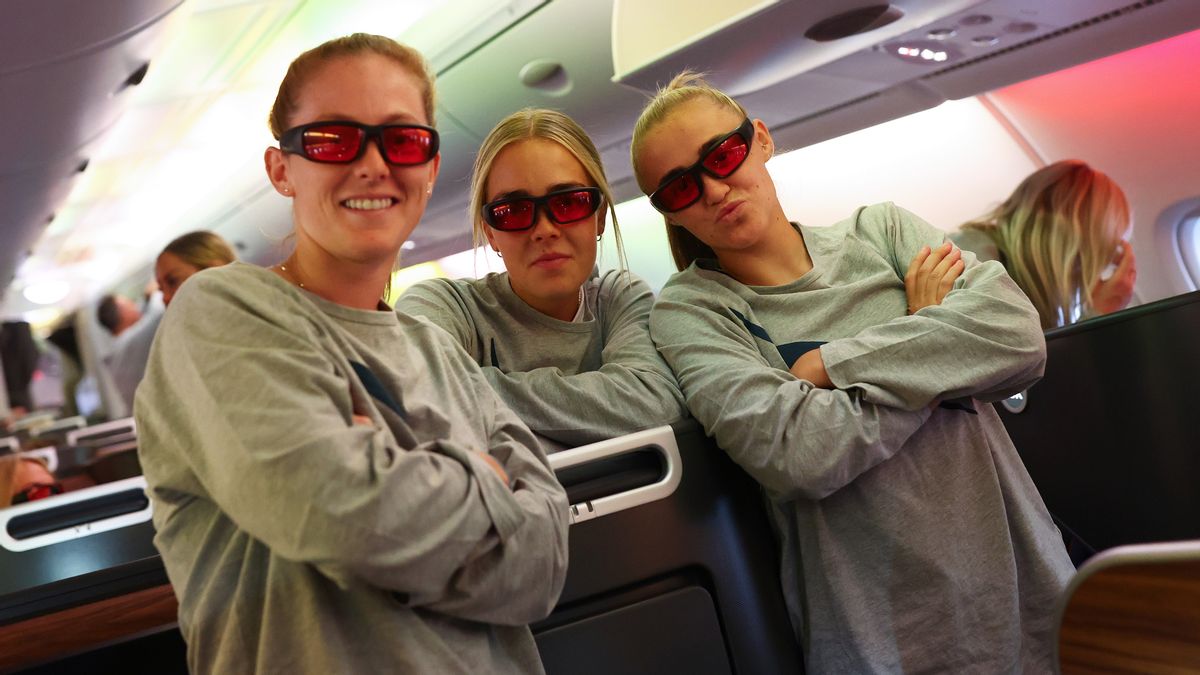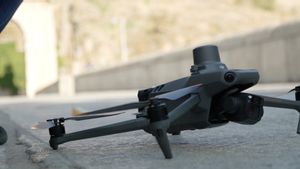JAKARTA - The England women's soccer team, Lionesses, are seen using special glasses that may be their key to overcoming jet lag during flights.
The European champions make the long trip to Australia on Wednesday, 5 July just days before the highly anticipated Women's World Cup in Sydney.
Keira Walsh, Ellie Roebuck, and Georgia Stanway were seen wearing these glasses to avoid fatigue from lack of sleep.
In a tweet, Lionesses wrote: 'Time to wear the chronos. We're doing our best to overcome the jet lag.'
The 255-pound (IDR 4.9 million) glasses were made by Netherlands-based Propeaq, which claims they can keep the mind and body alert at the right time.
"Fatigue, sleepiness, and unfocused diminish performance on a business trip or spoil the fun of a vacation," explains Propeaq on its website. "Prepare your body for different time zones by adjusting your biological clock at the right time. In this way, you avoid the uncomfortable feeling of tiredness and the appearance of puffy eyes."
Time for the chrono glasses.
Doing our best to beat the jet lag 👊✈️ pic.twitter.com/JhlPDor9r9
— Lionesses (@Lionesses) July 5, 2023
Jet lag, also known as circadian desynchronization, is a temporary sleep state caused by a mismatch between the body's biological clock and the external environment. Usually occurs due to fast air travel across continents and different time zones.
The Propeaq glasses aim to reduce the impact of jet lag through the use of interchangeable lenses with blue and red filters.
Dr. Neil Stanley, an independent sleep expert, says this concept isn't new, but is based on scientific belief.
"The thing that tells us it's time to sleep is the absence of blue light - think every sunset - it's usually red or pink. The absence of blue light tells us to sleep," says Stanley.
Propeaq also adds that "active" blue light suppresses the production of melatonin, known as the nighttime hormone.
Instead, it stimulates the production of cortisol — a hormone known to drive action — which simulates the sense that it's noon.
To use glasses properly, Propeaq suggests wearing them with the app.
Flight time and time zone information can be entered here so that Propeaq can let users know when to change lens color.
"Your biological clock is adjusted to sunrise and sunset," explains Propeaq.
"Those clocks can shift, but a maximum of 1.5 hours per day without being disturbed. So if you shift six time zones by traveling, you need four days of adjustment. You can do that in the four days before the flight, but also, for example, two days before departure and two days after arrival," said Propeaq.
Filtered glasses and their effectiveness have long been a source of controversy among sleep experts.
Dr. Stanley called blue light glasses a "waste of time" unless someone is wearing them under highly controlled conditions.
"It's not surprising that athletes adopt things like this. It's all about performance and optimizing for performance. But once you look at the sun, it completely erases what these glasses can do," Stanley said, quoted by MailOnline.
VOIR éGALEMENT:
"The sun is a million times stronger than anything these glasses can do. Unless they wear them all the time, it's a waste of time," he added.
Dr. Stanley said that the effect of the glasses would return to normal once they were removed. Even lighting indoors, taking a shower, or using an illuminated mirror is enough to signal the time.
To really overcome jet lag, Dr. Stanley advises travelers to stay awake when there is light and sleep when it's dark in their destination country.
She also suggests that eating food at the "correct" times will help maintain alertness — even if it's just a bar of chocolate and not a full meal.
Dr. Stanley believed that sending Lionesses to Australia two weeks before the games would be a good way to help overcome jet lag.
After the long flight to Australia, Georgia Stanway, and several other players were seen wearing no glasses at all.
A Propeaq spokesperson in charge of the Lionesses chrono training project told MailOnline that conditions were controlled "as much as possible" in a real-life environment.
They also explained that the app is not used in their training strategy, but that chrono nutrition is an important part of their methodology.
"An important factor in chrono training is obedience and discipline," they told MailOnline.
"Our method is used, among other things, by swimmers, hockey players, cyclists, synchronized swimmers, ice skaters, and many other top athletes, often with good results, especially if you keep to the schedule and instructions. That's why knowledge transfer is also a part of which is very important from our training.
"The best example is Belgian cyclist Victor Campenaerts, who took the world record hours from Bradley Wiggins in 2019. With the help of chrono training, Campenaerts shifted his rhythm about 6 hours early, so he had his best race in 1900m in Mexico at 11 o'clock morning," he added.
"The six-hour time change was necessary because the peak moment of performance is around 17.00 pm, but the air resistance and temperature in a bicycle race are most favorable at 11 am," he said.
"Afterwards, Campenaerts was very pleased with his use of the chrono training and light goggles. Interesting detail, his whole team shifted their sleep/wake rhythms together with him."
"Finally, chrono training is not a panacea, but when used properly it is a method to significantly reduce jet lag so that you recover more quickly and can return to the same level of performance quickly," he explains.
The English, Chinese, Japanese, Arabic, and French versions are automatically generated by the AI. So there may still be inaccuracies in translating, please always see Indonesian as our main language. (system supported by DigitalSiber.id)












